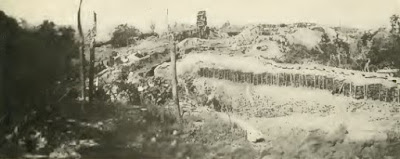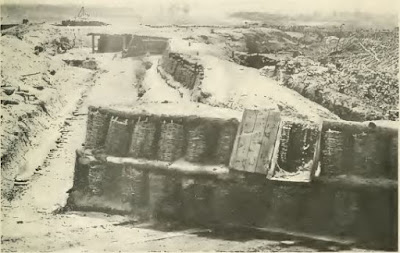Se conocen como Sap Roller a los tejidos cilíndricos que fueron utilizados durante la Guerra Civil en Norte América, con los cuales se formaban trincheras y además se utilizaban como elementos de defensa.
Estos gaviones eran construidos con maderas locales con las que se realizaba el tejido mediante una trama y urdimbre. Eran formas cilíndricas que no tenían base, pero cuando se colocaban de forma vertical a modo de fortificación se los rellenaba con tierra y sacos de arena formando anchos muros de defensa.
SAP ROLLER IN NORTH AMERICA
The cylindrical weaves that were used during the Civil War in North America, with which trenches were formed and also used as defence elements, are known as Sap Rollers.
These gabions were built with local woods with which the fabric was made by means of a weft and warp. They were cylindrical in shape and had no base, but when they were placed vertically as a fortification, they were filled with soil and sandbags forming wide defensive walls.
These gabions were built with local woods with which the fabric was made by means of a weft and warp. They were cylindrical in shape and had no base, but when they were placed vertically as a fortification, they were filled with soil and sandbags forming wide defensive walls.
Exitían distintos tipos de Sap Roller, según el uso que se le daba, unos mas ligeros para transportarlos con facilidad, otros rellenos con fajinas de ramas secas mas densos, etc.
Los gaviones, según su tipo, se construian con las mismas medidas ya que esto facilitaba las estrategias a la hora de saber cuántos Sap Roller eran necesarios para cubrir una superficie determinada, funcionaban como elementos modulares, también facilitaba el cálculo de distancias unas vez colocados.
There were different types of Sap Roller, according to the use it was given, some lighter to transport them easily, others filled with dry branches, etc..
The gabions, according to their type, were built with the same measures since this facilitated the strategies at the time of knowing how many Sap Roller were necessary to cover a determined surface, they worked as modular elements, also facilitated the calculation of distances once placed.
The gabions, according to their type, were built with the same measures since this facilitated the strategies at the time of knowing how many Sap Roller were necessary to cover a determined surface, they worked as modular elements, also facilitated the calculation of distances once placed.
Sap Roller son cilindros tejidos que alcanzaban los 3 o 4 m de largo y 60 cm de diámetro. Su tejido se realizaba mediante una trama y urdimbre de madera reciclada, y requería experiencia en cestería para su correcta realización. Unas 10 a 14 estacas se colocaban formando el circulo y alrededor de ellas se entrelazaban las ramas mas flexibles de madera formando el gavión, los tejidos se comenzaban a realizar desde la parte mas baja en el suelo donde las estacas etaban mas estables. La tensión que ejercía el tejido, hacía que las estacas se inclinaran hacia el centro, por lo que debía colocarse unos refuerzos en el centro del gabión y en la parte alta que mantuvieran el diámetro del circulo hasta que se llegara a entretejer todo. La terminación de las estacas era afilada, lo que permitía que se clavaran al suelo. Las uniones del tejido se reforzaban con alambre o cuerda. Los tejidos en zig zag, donde la trama pasa por delante y por detrás de la urdimbre generaban gaviones mas fuertes y resistentes a las cargas laterales y a la propia estabilidad.
Sap Roller are woven cylinders that reached 3 or 4 m long and 60 cm in diameter. Its weaving was done with a recycled wood weft and warp, and required experience in basketwork for its proper realization. Some 10 to 14 stakes were placed forming the circle and around them the most flexible branches of wood were intertwined forming the gabion, the weaving began to be done from the lowest part in the ground where the stakes were more stable. The tension exerted by the fabric caused the stakes to lean towards the centre, so reinforcements had to be placed in the centre of the gabion and in the upper part to maintain the diameter of the circle until everything was interwoven. The end of the stakes was sharp, allowing them to be nailed to the ground. The weave joints were reinforced with wire or rope. The zigzag weaves, where the weft passes in front and behind the warp, generated stronger gabions that were stronger and more resistant to lateral loads and to their own stability.
Fuentes / Source:
Miller, F. T., & Lanier, R. S. (1911). The Photographic History of the Civil War...: Armies and leaders (Vol. 10). Review of reviews Company.
http://lly.org/~rcw/cwf/dictionary/xgr-022.html
http://lly.org/~rcw/cwf/fortification_images/p2_02614u/index.html
http://tectonicablog.com/?p=93805
Imágenes / Pictures: (1,2,3,4,5) Miller, F. T., & Lanier, R. S. (1911). The Photographic History of the Civil War...: Armies and leaders (Vol. 10). Review of reviews Company.
 (1)
(1) (2)
(2) (3)
(3) (4)
(4) (5)
(5)
No hay comentarios:
Publicar un comentario